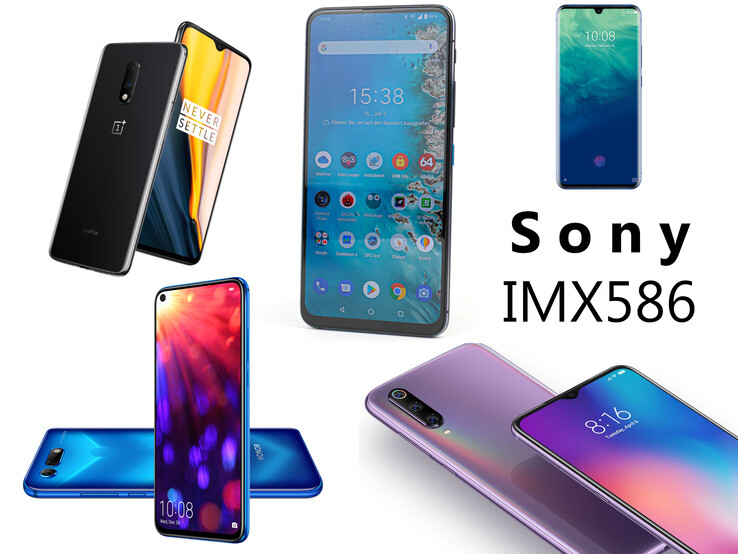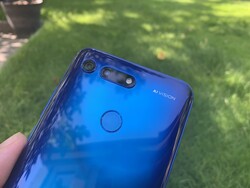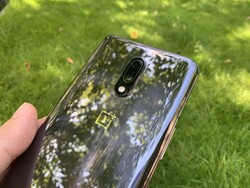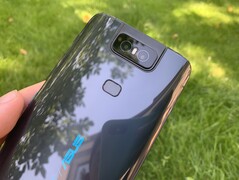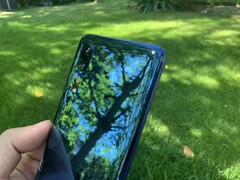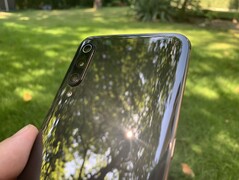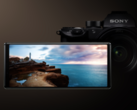Sony IMX586 Comparison Review: Five 48 MP smartphones face-off in a camera duel
Smartphones have now replaced compact cameras for many people, with OEMs now included good camera hardware in midrange smartphones. The Sony IMX586 has helped drive that move away from only flagship devices coming with decent cameras, as we have covered in several smartphone reviews that come with the 48 MP sensor. The IMX586 is more than the sum of its megapixels though, with it able to use pixel binning to combine 4 pixels into 1. Theoretically, pixel-binning should result in a better exposed and more detailed 12 MP image, with each pixel containing four times the amount of data that a pixel in a 48 MP image would.
We have covered the IMX586 extensively in the last few months, but we are yet to pit several OEMs implementations of the sensor against each other, which is the focus of this comparison review. We shall be using the ASUS ZenFone 6, Honor View 20, OnePlus 7, Xiaomi Mi 9 and ZTE Axon 10 Pro for this review, with all OEMs applying their algorithms within their in-house camera apps. Not all our comparison devices can shoot at 48 MP in their respective automatic modes, so we shall conduct our tests at 12 MP instead. The latter effectively increases the edge length of each from 0.8 μm to roughly 1.6 μm, which represents an increase in light sensitivity and should produce better-exposed photos, as we mentioned in the preceding paragraph. We shall leave any artificial intelligence (AI) optimisations activated too.
Camera Hardware
The first smartphone we reviewed with an IMX586 sensor was the View 20, which Honor complements with a time of flight (ToF) camera. The company not only allows the View 20 to shoot in 48 MP when using night-mode but it has also included an "AI Ultra Clarity" mode that one would primarily use to capture more details than would be possible with other camera modes. Incidentally, Honor uses pixel-binning for digital 2x zoom.
ASUS also complements the IMX586 with an additional sensor, but it is not a ToF camera. Instead, the Taiwanese company has included a 13 MP wide-angle camera. The IMX586 also doubles as a front-facing camera, with the ZenFone 6 having a motorised rear-facing camera housing that can flip up when you want to take a selfie. Currently, the ZenFone 6 is probably the only smartphone that uses pixel binning for selfies.
The OnePlus 7 has dual rear-facing cameras too, but its secondary sensor is a 5 MP one that can deliver up to 2x optical zoom. The latter can also help provide additional depth of field information for the IMX586 when shooting portraits, but not to the same extent as a ToF camera can.
Conversely, the Axon 10 Pro and Mi 9 both have triple rear-facing cameras, with Xiaomi and ZTE including ultra-wide-angle and optical zoom sensors. However, the Axon 10 Pro has the edge on paper, with ZTE including a 20 MP wide-angle sensor and a 3x optical zoom sensor to the 16 MP and 2x sensors in the Mi 9. The optical zoom sensor in the latter can shoot in up to 12 MP though, with the Axon 10 Pro limited to just 8 MP.
All five devices have a dedicated night mode for low-light photos. Accordingly, we shall be putting these modes through their paces. The OnePlus 7 can only shoot at 48 MP in pro-mode though, which is why we have limited our test shots to 12 MP for the sake of comparability.
| Asus ZenFone 6 | Honor View 20 | OnePlus 7 | Xiaomi Mi 9 | ZTE Axon 10 Pro | |
|---|---|---|---|---|---|
| Main camera | 1/2.0”, 0.8 µm, f/1.79 | 1/2.0", 0.8 µm, f/1.8 | 1/2.0", 0.8 µm, f/1.7 | 1/2.0", 0.8 µm, f/1.75 | 1/2.0", 0.8 µm, f/1.7 |
| 48 MP mode | yes | yes | only in pro mode | yes | yes |
| Ultra-wide-angle | 13 MP (125°, f/2.4) | no | no | 16 MP (f/2.2, 13 mm, 1/3.0", 1,0 µm) | 20 MP (f/2.2, 125°) |
| Optical zoom lens | no | no | 2x (5 MP, f/2.4) | 2x (12 MP, f/2.2, 54 mm, 1/3.6", 1.0 µm) | 3x (8 MP, f/2.4) |
| ToF camera | no | yes | no | no | no |
| Software version | PPR2.181005.003. WW_Phone-16.1210.1906.156-0 | 9.0.1.169 | 9.5.7.GM57BA | MIUI 10.2.28.0 | GEN_EU_EEA_ A2020GPro_V1.5 |
Daylight Photography
None of the five devices perform poorly in daylight shots, although it quickly became clear during our tests that OEMs have taken different approaches with post-processing. The ZenFone 6 performs particularly well with its HDR+ mode enabled, with it doing a good job at capturing the ripples in the water along with the fronts of the buildings in the background of our first test shot. The Mi 9 trails the ZenFone 6 here, with colours looking a bit too pale for our liking, although it captures a comparable amount of detail to the ZenFone 6 test shot. The View 20 fares the worst here because of its weak dynamic range and poor exposure. The test shot taken with the Axon 10 Pro looks rather dark too, but it captures colours noticeably more vividly, making it our favourite of the five devices here.
There were no aberrations during our next scenario either, with all our comparison devices capturing the flowers well. Colours look flat in the photo shot with the OnePlus 7 though, while the Mi 9 oversaturates the green leaves and makes the whole scene look too warm for our liking. The Axon 10 Pro offers the strongest colour contrasts here, but the View 20 produces the most colour balanced photo. There are similar differences between the five devices in our next scenario too, as the photos below demonstrate.
Twilight & Low-light Photography
We then moved onto our twilight tests, during which we took photos at 30- minute intervals. We also captured a second photo using night mode from the second interval onwards.
The ZenFone 6 performed best in the first round of shots, with it even giving the foliage and trees a decent amount of detail. The device makes the sky look a little overcast in some places, but its photo pleases us most overall. The Axon 10 Pro and OnePlus 7 take good shots too, but the Mi 9 and View 20 struggled to give the trees much definition. A thick layer of image noise covers the foliage in the photo shot by the View 20 too.
All our devices struggled to capture as many details 30 minutes later, while the ZenFone presented the most drastic change in exposure levels. The image produced by the View 20 is surprisingly well lit, but it still struggles to capture many details. The OnePlus 7 creates the most balanced image here, but it lacks the sharpness that the ZenFone 6 and Mi 9 achieve. Conversely, the Axon 10 Pro keeps the building nicely in focus, but everything looks overly dark.
In short, switching to night mode generally improved the dynamic range across the board. However, while it made some areas visible again that were previously lost, it also made some textures look unnatural and even a bit plasticky. Overall, most OEMs have done a good job with their night modes, although Xiaomi’s makes hardly any difference, while ZTE’s only delivers blurrier pictures.
As night descended we changed location, and again all our comparison devices handled the scene differently. Essentially, OEMs have gone down one of two routes for low-light shots, with our test photos either being exposed well at the cost of image noise or more natural-looking with less image noise but flatter dynamic range and a darker overall image.
You may prefer the View 20 here if you like the former approach, but this looked nothing like the scene as we saw it with our eyes. The Mi 9 reduces exposure levels a touch but still creates a nicely lit image. However, details look blurry. OnePlus and ASUS take the middle ground here, although the latter suffers from more image artefacts than the former. The Axon 10 Pro created the darkest photo of the five smartphones, almost eliminating picture elements like the road sign. With that said, its effort is also the least noisy, and has the best dynamic range.
Similarly, our comparison devices respective night modes all improve exposure levels but at the expense of image quality. The OnePlus 7 and ZenFone 6 perform the best in this regard; none do a stellar job though. Incidentally, all our test shots in these conditions looked great on small displays, so they should all be popular on social media.
Finally, we subjected our comparison devices to our NBC bunny, Android figurine and electrical candle scene, which you may have seen if you have read any of our smartphone reviews. This scene pushes the IMX586 to its limits, with its image quality falling short of the sensors in current flagships like the Galaxy S10+ or P30 Pro. All our test shots were taken with night mode disabled to make it that bit tougher for our comparison devices. Only the View 20 could capture a sharp and reasonably well exposed shot, but this comes at the expense of significant image noise. This is probably also a focusing issue, of which the View 20 should be doing a better job considering that it has a ToF camera. All other devices performed poorly in this test and demonstrate the weaknesses of the IMX586 in low-light conditions.
Portraits
The differences between our portrait test shots are distinct, with OEMs having implemented different focal lengths for their respective portrait modes. Xiaomi employs a drastic change here, with it increasing the focal length from 27 to 31 mm, which is why our test photo looks more zoomed-in than our other shots do.
Overall, the OnePlus 7 and ZenFone 6 create the most balanced shots to our eyes, primarily because no background areas look overblown as they do in the Axon 10 Pro and View 20 test shots. These two still take decent portrait photos though. The Mi 9 performs well too, but it struggles to keep hair follicles in focus and cannot capture our face as sharply as its contemporaries can. Likewise, while the Axon 10 balances colours nicely, it struggles with hair contours. The device also overemphasises the bokeh effect, making the resulting photo look too artificial for our tastes.
We also took some portrait shots at dusk to see how our comparison devices fared. All captured fewer details than they did in daylight, although the OnePlus 7 and Mi 9 struggled the most in this test as demonstrated by the photos below. The View 20 does not do a great job either, with the photo looking comparatively dark and lacking in focus despite its more harmonious white balance. The Axon 10 Pro takes a slightly brighter shot here, but while overblowing the sky and giving everything a more reddish tint. The ZenFone 6 performs best here too.
Parenthetically, none of our comparison devices allowed us to set the white balance manually in portrait mode.
Controlled Lighting Conditions
Finally, we moved onto tests under controlled lighting conditions, during which we photographed our test chart at 1,000 lux, 100 lux and 1 lux. None of the devices showed any weaknesses at 1,000 lux, although the Mi 9 and ZenFone 6 maintained an evener contrast across the whole chart than their contemporaries did.
Dropping to 100 lux highlighted the differences between the five devices, with the ZenFone 6 performing surprisingly poorly in this light, as does the View 20. The Mi 9 makes a slightly brighter representation than these two devices but at the cost of more image noise. The OnePlus 7 balances contrast and exposure levels well, but its photo also suffers from image noise. The Axon 10 Pro is comparable to the OnePlus 7 here, although its effort is slightly sharper while also looking too pale for our liking.
In short, all our devices perform dreadfully at 1 lux, with only the Axon 10 Pro capturing any details. By contrast, the View 20 makes a mess of our chart, while the ZenFone 6 picks up hardly any of it at 1 lux. The Mi 9 does slightly better than the ZenFone 6 here and picks out some white boxes, but the chart looks overly dark. The OnePlus 7 tries its best to light the chart well, but details are blurry and are covered in a thick layer of image noise.
Verdict
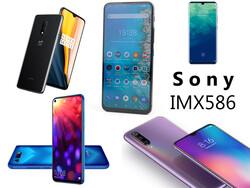
Our five comparison devices have all utilised the IMX586 differently. All the devices take good shots in daylight, but some favour richer contrast and higher dynamic range over colour accuracy and details than others. Neither are wrong approaches, with a preference ultimately being a matter of taste.
Our twilight and low-light tests emphasised the differences in these approaches, with some IMX586 sensors delivering a better lit picture at the expense of image noise. The IMX586 can produce a natural-looking photo in low-light, but you must make do with objects being more poorly exposed. Alternatively, one could use night mode, although the results still vary between devices and occasionally look overly artificial. This approach to photography may suit those who only plan to upload compressed photos and videos to social media but using night mode on the IMX586 will disappoint those who like to print their photos or re-watch their videos on large external displays.
The Sony IMX586 takes impressive daylight pictures irrespective of the device in which it is housed. However, it reaches its limits in low-light, with its deficiencies often amplified by overaggressive post-processing.
Portrait mode highlights the difference in image quality between our comparison devices, with the ZenFone 6 coming out on top. The other four still take good portrait shots, but they all suffer from a few image artefacts.
Overall, we cannot choose a clear winner from our five comparison devices. Objectively, there is little to choose between them, although we preferred the dynamics, contrasts and vivid colours that the Axon 10 Pro produced in our daylight tests. Conversely, the ZenFone 6 has the edge over its contemporaries when shooting portrait, but the OnePlus 7 and Axon 10 Pro generally take better photos in low-light.




